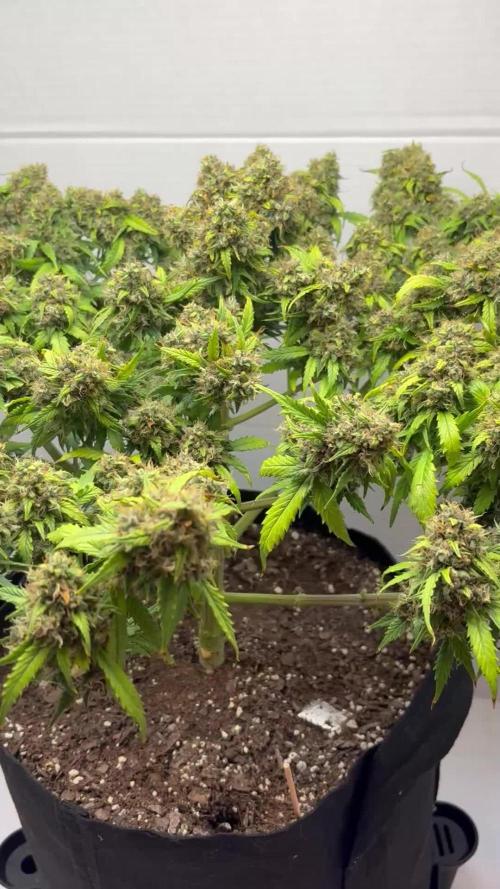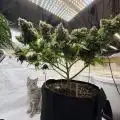The Grow Awards 2026 🏆 

































Likes
45
Share


@BodyByVio
Follow
Beautiful flower full of trichomes. Smell and test fantastic. Very fast flowering. She was done on day 49 but I cut her down few days later.
I love the strain, the only thing that I will like this strain to have is a better yield. Beast quality buds I ever grew.
Likes
7
Share


@GrownyStark
Follow
After some adjustments needed due to the heat of the lamp, I was able to stabilize my tent temperature to under 26c.
I had to move the light to 2 ft away dimmer at 80% as the tips of new leaves shooting up fast and showing light burns. Mysoil PH climbed to 7.5 so I adjusted ph using big bud by advanced nutrients which drops my solution to 6. This will work for the time being. I've opened up the tent to allow air to flow more freely from the room as the outside air being pulled in had less than 400ppm after some careful measurements. This lead to drops down to 330ppm. I have since closed the vent. Opening up the tent increased co2 levels by 2-3 times. I overkilled fan department added a 16 inch oscillating fan. In the morning it has a strong smell before lights on.
Likes
11
Share


@Jays_Not_Here_Man
Follow
Seedling is doing well, trying not to over water and keep the RH high around 68-70%. Changed the light schedule to 18/6 mid week. Seems to be doing ok with the slightly colder temps at night. Happy Gardening 🇨🇦👊❤️
Likes
13
Share


@Ieiogrow94
Follow
Eccoci qui...
Tutto va per il meglio, questa settimana si inizia a vedere la resina e ora si inizieranno a formare le cime, per questo aggiungo Sugar Shot di @xpertnutrients vedremo l'evoluzione settimana prossima.
Odore intenso di Big Bubble, strato di resina pazzesco e numero di cime formate più alto di tutto il ciclo, sono molto curioso di questa varietà....
STRAORDINARIA
Grazie a tutti per il supporto🔥🌲❤️
Likes
8
Share


@AtticGrowing
Follow
This girl did amazing, even after being blasted by a space heater. Strong secondary branching, big colas producer, nice trichomes coverage and good bud density.
Likes
51
Share


@dalemac
Follow
September 25 > Harvest at dawn for the big girl. The usual routine... except I shot a time-lapse video this time to play with the camera I won last year. Clipped the top buds first - then the base. Took me 2 hours to wash all that -rinse - repeat.
----------------------------------------
Well this was an interesting summer with this pair of girls.
I learned that I don't really need a container larger than 10 gallons in order to grow very large plants (in my neck of the woods anyway). Now when I say large I mean how much space they take up on my patio. I'm allowed to grow 6 legally but 4 eats up pretty much the whole patio. And the reality is I don't need to grow plants that large. The outdoor yield will last well into next year for me and everybody I know. So next summer I plan to do much more serious pruning to limit the scope and shape of the girls I grow outdoors.
I also learned that I don't need an inverted tomato cage style support if my container is larger than 5 gallons. The Durban I grew last summer was in a 5 gallon container and there's not enough weight in there to keep her grounded. Once up to 10 gallons you won't want to lift the container much and there's enough weight in there to keep things stable.
At the moment I've listed 450g as a dry weight for both plants (updated to 458g final). I haven't actually weighed the 2nd plant yet and won't even trim her for about a week or so (I'll be back to update diary). The first girl came in at 235 grams. I got pretty ruthless throwing away small budlets and trim this morning as it took me 4 hours to take this big girl down and wash her up. That's only because I spent half a day yesterday trimming Cream & Cheese and moving Northern Lights around... and it's been over 95 degrees both days... so I'm ready for a rest. Cannabis harvesting is not easy labor.
Diary note > There was a software malfunction a week or so back and I was unable to add a new flowering week, whereupon it was determined there was a limit of 26 weeks at that time... so I didn't add any more weeks after that until the harvest week. When I added the harvest week, it appears the malfunction had been corrected because I COULD HAVE added a new flowering week at that time. I think there's only a week missing. Differences can be noted with dates on the photos.
If I had a problem this summer it's because I was too anxious to get going after a long winter nursing shoulder surgery and I didn't pay proper attention to the lighting ramifications when the instructions were there for me, and subsequently started too early. Next year I plan for an early crop of auto flowers to keep me occupied until the proper time for a regular crop.
---------------------------------------
September 30 > Trimming and processing complete. I really manhandled the big girl with the Trimbag, largely because I knew I was gonna have a pound of herb on my hands (way more than I will personally consume) and I wanted to minimize my hand trimming. So when I say manhandled here, I mean I ran it through the process TWICE, using about 40 rotations/spins each time. It probably would have helped to be a tad drier, but we're entering a cool spell now and we've run out of time. Mother Nature has decided to turn off the heater... which has turned my Purple Berry Kush a nice shade of purple... but that's tomorrow mornings's harvest... <sigh>... anyway... where was I... oh yeah... AMNESIA... <hehe>
Trimbag generated trim on 1st pass = 217 g
Trimbag generated trim on 2nd pass = 90 g
Trim generated by hand after that = 186 g
Final bud weight for big girl = 223 g
Clearly, comparing weight of trim generated by hand vs by the Trimbag here you can see the result of my "manhandling".
Little girl was in a 10 gallon pot and generated 235 g buds and 360 g trim.
Big girl was in a 15 gallon pot and generated 223 g buds and 493 g trim.
Final total bud weight 458 grams for both plants.
Hope anybody following along learned something this summer. I did.
😎
The trick is to not make the same mistake twice. That's kinda why we're all here. Kinda. ✊
Likes
9
Share


@Rckeh
Follow
Day 87 - Feeding day today. Removed Acti_Vera completely. She´s really starting to look mature. Tomorrow ill check trichomes. Also slightly defoliated dying leafs and to get more light at lower buds. They´re also developing well.
Day 90 - Still see some clear trichomes. Will keep the plan i had in mind, ill feed her one more time and start flushing at the end of this week. This beast is really getting beautifull, love this fruity hashy blueberry aroma. Fingers really get sticky.
Day 91 - Last feeding today.
Day 93 - She´s really getting mature, so today i will start flushing. At the end of next week i´ll harvest. Flushed 3L of pH´d water (around 6)
Likes
35
Share


@Eryan
Follow
Day 49 - Clearly she's starting to get to the end of the life-cycle. The nutrient reserves are being used up in the leaves, although I also suspect a bit of nutrient lockout as well. Today only gave PH'ed water. After taking another look at the trichomes today, I'm starting to wonder if she really is ready for harvest yet or not 😅 I guess I'll take another video in a few days and see how they look then. The pistils are curling in though now, so that's one sign that harvest is getting closer.
Day 53 - Watered again today; she was a little droopy 😳 PH was about 6.05
And took another video of the trichomes...a good one this time. And what do you know...plenty of the trichomes still look clear AF, although I do notice some amber ones. Going to wait until at least next week for sure now to harvest.
Likes
80
Share


@Greenwolvesfarmer
Follow
Súper bien .lindo crecimiento . Sigue con sus hojas anchas y algo más gruesa que las hermanas del armario ...
Tranquilo y a disfrutar ...esperando con ansias , ya te quieres cambiar de camita bebé ...te amo nena ...
Gracias padre Sol y madre tierra por bendecir el día a día ..
Likes
2
Share


@burnercorona
Follow
Awesome week. Both plants are doing great. One is definitely praying to her Blue God lol.
Likes
10
Share


@Ferenc
Follow
Day 72: 600W LED, 18 hours on 6 hours off the same with ventilation. Ferilization is the same. Water intake also remains the same 200ml per day. Humidity approx 35 percent.
Day 74: She needs a bit more time to be done like 2 weeks from now.
Likes
18
Share


@raulmoat123
Follow
These girls are packing on weight and very very quickly, front 2 are watermelon punch , back 3 are blue gelato those buds are like boulders so dense and heavy you can see the weight of the buds when the plants are blowing , inhouse genetics terples are huge and taller , wedding cake is so frosty
Likes
8
Share


@BossberryFarms
Follow
Harvest Week!!
WET WEIGHT
Plant C: 597g
Plant B: 605g
Plant D: 413g
I will update as soon as I harvest the last plant and get dry weights 😉
Likes
11
Share


@adam_pawloski87
Follow
Let’s Go!! What another great week it’s been, all babies have got there tops an looking super healthy!
Likes
2
Share


@CannaIGrow
Follow
Transplant week! Some of the girls in the tent started to droop but this one didn’t! She’s looking pretty good to me
Come hang out with us in the discord!
Likes
13
Share


@Seven1AteChef
Follow
Week 3 for my replacement. Seeing some yellow leaves at the base. Not freaking out yet because the top leaves are okay.
The 9 week plant whew! Before I could only smell it if I rubbed the stems. Now, I get a slight smell as soon as I open the tent up. It’s not overpowering at all, and really pleasant.
Is it okay if the goers touch the wall of tent?
Likes
36
Share


@GYOweed
Follow
New rule:
If your fan leaves aren't bigger than your hand and super green after a month of veg in 3 gallon pot then you got the wrong genetics or something.






















